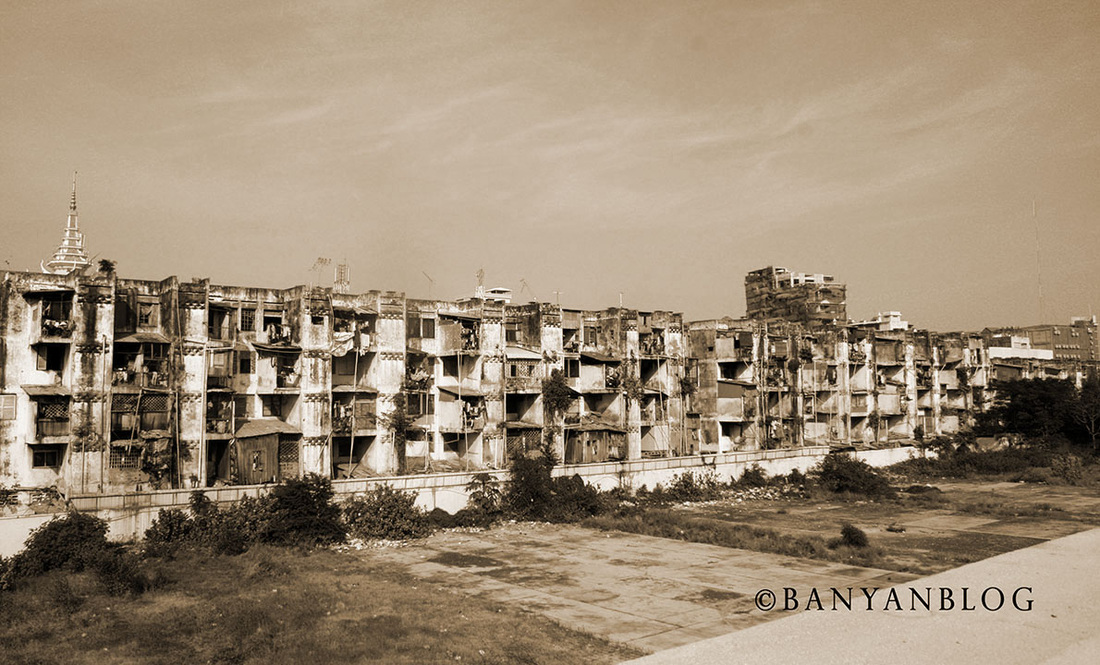| BANYAN BLOG |
banyan blog
 White Building, Phnom Penh, 2014. Built in 1963 by Cambodian architect Ly Ban Hap & Russian architect Vladmir Bodiansky, under the leadership of renowned Cambodian architect, Vann Molyvann. Residents of the building are mostly civil servants, artists, and shopkeepers. A historic site, now there are rumors the building will be demolished. See a slideshow of the building at end of the story. All images © Banyanblog 2014. Part I: An Outsider’s Perspective When I moved to Phnom Penh last year, I never heard of the White Building. We first lived in the Wat Phnom area and eventually settled down in the Chankarmorn district. Then the White Building was right in front of me, evoking a range of thoughts, fluctuating between seeing it as an eye sore, to a curious fascination of what life was like inside. As it became part of my daily line of vision, I often wondered who lived there? From the outside it looked old, dilapidated, and unsafe. In the daytime, it seemed to be surrounded in a swarm of chaos with shopkeepers selling their goods, children running without shoes, friends chatting in makeshift cafes and barbershops, couples fighting, monks gathering alms, and scavengers digging the trash to find bottles or cardboard to recycle. At night it seemed to be shrouded in mystery, evoking images of unpleasant things happening beneath dark stairwells. These images were all crossing my path, moving along to the rhythm of life there. The building served as a backdrop that seemed to symbolize to outsiders a negative narrative of the country, poverty in plain sight, in the midst of an up and coming area of the city. Icons of the new Phnom Penh are being propped up in a rampant effort to create a new metropolis, particularly in the Chamkarmorn/Koh Pich area, with rapidly growing luxury housing, fine dining, a new casino, and a new high-end mall. These are all in the vicinity of the building and illustrate the stark contrasts of economic inequality that are pervasive around the city. As I passed by on a daily basis, my own ignorance wondered, why doesn’t the city just tear down this place? But that was before I went inside, before I spoke with Pheak Samnang*[1] and before I discovered another side of the narrative, which goes beyond what you see with the naked eye. History of the White Building[2] The White Building was built in 1963 during Prince Sihanouk’s Sangkum Niyum era. It was a renaissance period for Cambodia under which the country became known as the ‘pearl of Asia’, through a revival of arts and culture, enhanced investment in education, and growing infrastructure development. The building was jointly designed by Cambodian architect Ly Ban Hap and Russian architect Vladmir Bodiansky, under the umbrella of the Bassac River Front Cultural Complex, which was under the guidance and leadership of renowned Cambodian architect, Van Molyyvan. When it was first inaugurated in 1963, there were 468 apartments, which housed lower and middle class Cambodians, mostly artists and civil servants. When the Khmer Rouge took over in April 1975, the residents, along with millions of others in Phnom Penh were evacuated. Part II: An Insider’s Perspective The Story of Mr. Pheak Samnang: A Resident of the Building Mr. Pheak Samnang was born in Pursat. He attended high school and pursued his studies to become an artist. In April 1975, during Khmer New Year, the Khmer Rouge entered his commune and ordered everyone to evacuate because the Americans were going to bomb it. Mr. Samnang was 18 years old at the time. Like many Cambodians, Mr. Samnang suffered under the Khmer Rouge. He lost his family members and was forced to marry during the regime. In 1979 the Vietnamese army came and liberated Cambodia from the Khmer Rouge. With no work in Pursat, he went to Phnom Penh in 1980 to find a job in the capital. He eventually found work at the Ministry of Culture and moved into the White Building in 1981. His wife and his son later joined him in Phnom Penh. As a civil servant at the Ministry, his monthly salary was 30 kilos of rice (per family) and he would occasionally receive one liter of cooking oil and some fish. Then the government gradually introduced money and he was given 180 riel per month[3] (estimated equivalent $45 today). In 1981 he paid 100 riel ($25 today) to buy an apartment at the White Building. There weren’t many people living there at the time and his neighbors were few and far between. When he first moved into the building, there was no running water. He had to walk down flights of stairs to fetch it. There was no electricity. Trash was piled high around the complex. The trash got so bad that every Sunday the Ministry of Culture organized a day where civil servants from the ministry, including himself, would clean up the building. Mr. Samnang has worked for the Ministry of Culture for over 30 years. His current salary is $100 USD a month. He no longer receives the rations of rice, and the occasional liters of oil or batches of fish from the government. Sometimes he makes extra money on the side by selling his artwork to customers. He spends half his salary, around $50 a month, on water and electricity. The rest is on food and expenses for the children. While it is easier now with modern conveniences (washing machine, electricity, and running water), the cost of living is much higher and the building has many more people. In some ways it was easier back then. He is a proud man who has managed to raise his four children well. All of them grew up in the White Building. Two of them have studied abroad. He’s always felt the building was a safe environment for them. It was a convenient place to go to school, easy commute to work, close to the markets, and afforded them the opportunity to be exposed to a rich community of artists that live in the building. He admits there have been times when there have been robberies and unsavory characters lurking around. Around 1997 or 98, robbers stole the metal handrails on the stairwells to sell. One time he heard a robber jump on his roof as he tried to run away. Those are the worst incidents he recalls in his 30 years of living there. He tells me those that give the building a bad name, the streetwalkers and drug dealers, don’t own an apartment at the building. Most of them are temporary renters or solicitors loitering in front of the building at night. Like clockwork, these characters appear out of the shadows from 12AM-2AM, meet outside in front of the building along Sotheros Boulevard, and wait for their customers. Most of the time they don’t come inside of the premises and are scared of the residents who will often call the police. “The images of them being down there are what give us a bad name”, he says. He then tells me a Khmer proverb “trei muoy kan’trok, sa’ouy muoy, sa’ouy tung’ah”, one bad fish in a basket, spoils all the fish. He informed me that a majority of people living in the building are civil servants (many of whom work for the Ministry of Culture), artists, and shopkeepers. Most of them wake up early in the morning, go to work and make an honest living. They work hard to raise their children as best as they can. The others are not part of the community and most of them don’t live in the building, nor have any history there. Rumors On September 3rd the Cambodian Daily published an article titled “Historic White Building to Be Demolished.” When I asked Mr. Samnang about the recent story, he said he hasn’t heard anything. When we discussed this, his calm pleasant voice turned tense as he spoke of these rumors and those creating them. “Those are just rumors. Those people who spread these rumors, do they live here or do I live here? Since I’ve lived here I haven’t come across any problems. I’ve never felt the building is unsafe. It’s very sturdy. The ones who would die in here are not them, it is me and my family. I live here. I know what it’s like. I would know if this building is in a bad condition and if it is unsafe to live here. I am not dying here. I would move if it was bad.” As a government worker, he is proud to serve his country for over the last 30 years. He says if the government comes to him and tells him they need the building to help the country develop, then as a civil servant, he would be happy to help. “If the government wants the building for development we are happy to help our country prosper, because this building is old and in the middle of the city. I pray that the government will do good for the people. I just want them to talk to us. No more rumors.” He tells me most of the residents are of the same mindset. They aren’t unreasonable. They just want to be treated fairly, and justly compensated. If they move them, it has to be at a place that is close enough to the city (from where they were) where parents can still send their children to school, close enough they can still go to work/access markets, and have running water and electricity. Now there are reports in the papers that city officials are backtracking on their statements that the building will be demolished, amid an outcry for support to save the building from tenants and civil society groups. Instead of demolishing, most residents, including Mr. Samnang, hopes the building will be saved and renovated. The future of the White Building is still uncertain. It remains to be seen what the government and the private company will do moving forward. Mr. Samnang is not naïve to think that what has happened in other places, such as Borey Keila and Bang Kak Lake, won’t happen to the residents of the White Building. He’s heard the stories, and believes perhaps, they are the last one. But he hopes that because so many residents in the building are civil servants, who like him, have served the government for so long, that they would have the support of the government to help. “I think many of us have served the government. I have been a civil servant for over 30 years. If I am poor, I am poor. The rich will have it. I will not talk bad about the government. If the government makes me suffer, then I don’t know what to do. But I try not to think about it because it hasn’t happened to us.” Part III: Eyes Wide Open It’s been an eye opening experience learning about the building through a resident who has lived in it for so long. My once distant fascination has now evolved to a close and personal account of a humble man’s life. Throughout the interview he never complained about his living situation, his country or his circumstances in life. He was angry and passionate when he spoke of rumors that the building will be demolished. It wasn’t so much the possibility of it being demolished that made him angry, but that those who were considering it, didn’t even ask the opinions of the residents. There are many more like him that live in the building, whose stories are yet to be told, but hold the same spirit. My opinion of the building, before learning about the people who lived here, and the history of it, was unfounded. Unfortunately, the problem is, I am not alone. There will be many people who pass by the building and see it as I did, an old and decrepit place. Because it is juxtaposed by a more polished and refined image of Cambodia, gleaming towers and upscale restaurants around it, there is an instinctive notion that structures like these, worn by time and neglect, symbolically hold the country back. That it serves as a constant reminder of the problems the country wants to brush under the rug, or in this case, demolish, instead of putting the hard work needed to clean it up and make it better. We need to look beyond what it currently is and envision what it could be. The White Building can serve as an example to the younger generation of a time when a significant part of our architecture were proudly designed, created and led by Khmers for Khmers. That instead of destroying part of our past, one building, one block at a time, we see it as an opportunity to restore our culture, our history and identity for this generation, and many more to come. This can all be in done in conjunction with, not in lieu of, building a new dynamic metropolis for our country. That instead of tearing it down and removing a rich icon of our recent history, we proudly fix it, shine it and prop it back up, like an old treasure. Every life has a story of struggles and triumphs. For a moment, I hope this story helps you to see beyond the worn out façade of the building and makes you think twice about the people who live there. That when you pass by it, you think of people like Mr. Samnang, who makeup the majority of the residents who are hardworking, honest individuals just trying to raise their families in peace. As with any human being, they just want to be treated with respect, dignity and fairness. Many residents of the building love their country very much and want to see it prosper. For all the years they have served it, they hope their country can help standup for them, and protect them. This may all seem unrealistic in the wake of other examples that have not ended well. But hopefully the story of the White Building will have a happier ending. [1] Name changed to protect his identity. [2] The original source of the history of the White Building in this section was derived from the White Building Project at www.whitebuilding.org [3] The riel was officially circulated on March 20, 1980. The estimated value of the riel back then was 4 riel to 1 USD. All images © Banyanblog 2014.
1 Comment
|
FEATURED INMOST POPULARThe Journey Archives
October 2022
follow |
© banyan blog 2013-2022
All Rights Reserved
All Rights Reserved


